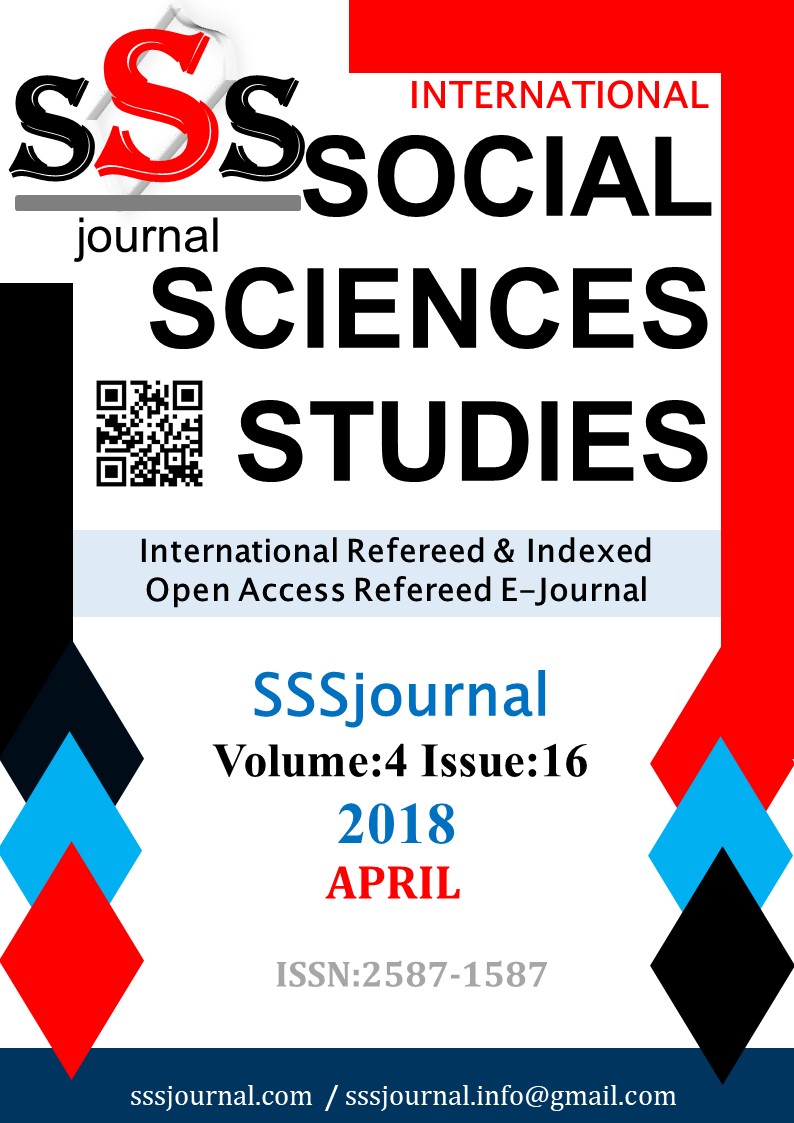THE EFFECT OF R&D EXPENDITURES ON HIGH-TECH MANUFACTURING INDUSTRY EXPORT: THE CASE OF OECD COUNTRIES
Author :
Abstract
Bu çalışmanın amacı, AR-GE harcamalarının yüksek teknolojili imalat sanayi ihracatı üzerindeki etkisini, 24 OECD ülkesi ve 1996-2015 dönemi için analiz etmektir. Çalışmada bu etkiyi belirlemek için Panel En Küçük Kareler, Sabit Etki ve Tesadüfi Etki modelleri kullanılmıştır. Ampirik literatürde AR-GE harcamalarının toplam ihracat ve yüksek teknolojili ihracat üzerindeki etkisini araştıran çok sayıda çalışma olmasına rağmen, bu etkiyi imalat sanayi alt sektörleri ile analiz eden az sayıda çalışma mevcuttur. Bu çalışmada AR-GE harcamalarının yüksek teknolojili imalat sanayi ihracatı üzerindeki etkisi, Standart Uluslararası Ticaret Sınıflaması (SITC) Rev.3’e göre, 3 dijitli veriler ile analiz edilmiştir. Çalışma literatüre bu konuda katkı sağlamak açısından önem arz etmektedir. Veri setine en uygun model olan Sabit Etki Model sonuçlarına göre, ele alınan OECD ülkelerinde AR-GE harcamaları ve yüksek teknolojili imalat sanayi ihracatı arasında önemli ve pozitif yönlü bir ilişki vardır. Ampirik sonuçlar bu konuda yapılan çalışmalar ile büyük ölçüde tutarlıdır.
Keywords
Abstract
The aim of this study is to analyze the effect of R&D expenditures on high-tech manufacturing industry export for the 24 OECD countries in the period 1996-2015 with Panel Ordinary Least Squares (OLS), Fixed Effects (FE) and Random Effects (RE) Models. . Although there are a lot of studies that analyzed the impact of R&D expenditures on total exports and high-tech export, there are few studies that analyzed the effect of on high-tech manufacturing industry export with the sub-sectors of manufacturing industry in the empirical literature. In the study, this effect is investigated according to Standard International Trade Classification (SITC Rev.3) by including 3-digit datas. Because of this reason, the study is important to contribute to literatüre. According to the FE Model results which is the most appropriate model for data set, in the OECD countries considered, there is a significant and positive relationship between R&D expenditures and high-tech manufacturing industry export. Analysis results are largely consistent with theoretical and empirical literatüre.
Keywords
- Basile, R. (2001). “Export Behaviour of Italian Manufacturing Firms Over The Nineties: The Role of
- Basile, R. (2001). “Export Behaviour of Italian Manufacturing Firms Over The Nineties: The Role of Innavation”, Research Policy, 30: 1185-1201.
- Bojnec, S. and Ferto, I. (2011). “Impacts of Research and Development on Manufacturing Trade”, Proceedings of Rijeka Faculty of Economics, 29(1): 65-88.
- Braunerhjelm, P. and Thulin, P. (2006). “Can Countries Create Comparative Advantages? R&D-expenditures, high-tech exports and country size in 19 OECD-countries 1981-1999”, Centre of Excellence for Studies in Science and Innovation (CESIS) Electronic Working Paper Series, 61: 1-31.
- Caldera, A. (2010). “Innovation and Exporting: Evidence from Spanish Manufacturing Firms”, Review of World Economics, 146: 657-689.
- Dam, M.M. and Bulut, Ş. (2016). “Dış Ticaret ve Ar-Ge Yatırımları Arasındaki İlişki: OECD Ülkeleri İçin Panel Veri Analizi”, Akademik Bakış Dergisi, 56: 345-358.
- Göçer, İ. (2013). “Ar-Ge Harcamalarının Yüksek Teknolojili Ürün İhracatı, Dış Ticaret Dengesi ve Ekonomik Büyüme Üzerindeki Etkileri”, Maliye Dergisi, 165: 215-240.
- Halpern, L. and Muraközy, B. (2011). “Innovation, Productivity and Exports: The Case of Hungary”, Economics of Innovation and New Technology, 1: 1-23.
- Hirsch, S. and Bijaoui, I. (1985). “R&D Intensity and Export Performance: A Micro View”, Review of World Economics, 121(2): 238-251.
- Hirsch, S.; Kalish, S. and Katznelson, S. (1988). “Effects of Knowledge and Service Intensities on Domestic and Export Performance”, Weltwirtschaftliches Archive, 124(2): 230-241.
- Ito, K. and Pucik, V. (1993). “R&D Spending, Domestic Competition, and Export Performance of Japanese Manufacturing Firms”, Strategic Management Journal, 14(1): 61-75.
- Kagochi, J. M. and Jolly, C. M. (2010). “R&D Investments, Human Capital, and the Competitiveness ofSelected U.S. Agricultural Export Commodities”, International Journal of Applied Economics, 7(1): 58-77.
- Kılavuz, E. and Altay Topcu, B. (2012), “Export and Economic Growth in the Case of the ManufacturingIndustry: Panel Data Analysis of Developing Countries”, International Journal of Economics and Financial Issues, 2(2): 201-215.
- Kılıç, C.; Bayar, Y. and Özekicioğlu, H. (2014). “Araştırma Geliştirme Harcamalarının Yüksek TeknolojiÜrün İhracatı Üzerindeki Etkisi: G-8 Ülkeleri İçin Bir Panel Veri Analizi”, Erciyes Üniversitesi İktisadi ve İdari Bilimler Fakültesi Dergisi, 44: 115-130.
- Landesmann, M. and Pfaffermayr, M. (1997). “Technological Competition and Trade Performance”, Applied Economics, 29(2): 179-196.
- Ortega, C.B.; Benavente, J.M. and Gonzalez, A. (2013). “Innovation, Exports and Productivity: Learning and Self Selection in Chile”, Working Papers, University of Chile, Department of Economics, wp371: 1-31.
- Özer, M. and Çiftçi, N., (2009). “Ar-Ge Harcamaları ve İhracat İlişkisi: OECD Ülkeleri Panel Veri Analizi”, Dumlupınar Üniversitesi Sosyal Bilimler Dergisi, 23: 39-49.
- Özkan, G. and Yılmaz, H. (2017). “Ar-Ge Harcamalarının Yüksek Teknoloji Ürün İhracatı ve Kişi BaşıGelir Üzerindeki Etkileri: 12 AB Ülkesi ve Türkiye İçin Uygulama (1996-2015)”, Bilgi Ekonomisi ve Yönetimi Dergisi, XII(I): 1-12.
- Sandu, S. and Bogdan, C. (2014). “Impact of R&D and Innovation On High-Tech Export”, Procedia Economics and Finance, 15: 80-90.
- Sterlacchini, A. (1998). “Do Innovative Activities Matter to Small Firms in non-R&D Intensive Industries? An Application to Export Performance”, Research Policy, 28: 819-832.
- Sungur, O.; Aydın, H.İ. and Eren, M.V. (2016). “Türkiye’de Ar-Ge, İnovasyon, İhracat ve EkonomikBüyüme Arasındaki İlişki: Asimetrik Nedensellik Analizi”, Süleyman Demirel Üniversitesi İktisadi ve İdari Bilimler Fakültesi Dergisi, 21(1): 173-192.
- Uzay, N.; Demir, M. and Yıldırım, E. (2012). “İhracat Performansı Açısından Teknolojik Yeniliğin Önemi: Türkiye İmalat Sanayi Örneği”, Doğuş Üniversitesi Dergisi, 13(1): 147-160.
- Verspagen, B. and Wakelin, K. (1997). “Trade and Technology from a Schumpeterian Perspective”, International Review of Applied Economics, 11(2): 181-194.
- WB, World Bank (2018). World Development Indicators-WDI Database.
- UN, United Nations (2018). International Trade Statistics Database, UN Comtrade.
- UNCTAD, United Nations Conference on Trade and Development, SITC Rev.3 Products, by Technological Categories (Lall (2000), http://unctadstat.unctad.org/EN/Classifications/DimSitcRev3
- Products _Ldc_Hierarchy.pdf,06.02.2018.
- Yıldırım, E. and Kesikoğlu, F. (2012). “Ar-Ge Harcamaları ile İhracat Arasındaki Nedensellik İlişkileri:Türkiye Örneğinde Panel Nedensellik Testi Kanıtları”, Marmara Üniversitesi İ.İ.B.F. Dergisi, 32 (1): 165-Zhao, H. and Li, H. (1997). “R&D and Export: An Empirical Analysis of Chinese Manufacturing Firms”, The Journal of High Technology Management Research, 8(1): 89-105.





